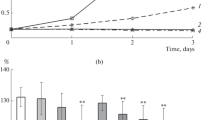Abstract
-
1.
Comparisons were made of the effects of salt on the exponential growth rates of two unicellular algae,Dunaliella tertiolecta (marine) andDunaliella viridis (halophilic).
-
2.
The algae contained glycerol in amounts which varied directly with the salt concentration of the growth media. The highest measured glycerol content ofD. tertiolecta was approximately equivalent to 1.4 molal and occurred in algae grown in 1.36 M sodium chloride. The highest glycerol content measured inD. viridis was approximately equivalent to 4.4 molal and occurred in algae grown in 4.25 M sodium chloride. Lower concentrations of free glucose, which varied inversely with extracellular salt concentration, were also detected.
-
3.
It is inferred that Na+ is effectively excluded from the two algae. There was some evidence of a moderate uptake of K+.
-
4.
Comparisons were made of erude preparations of the glucose-6-phosphate dehydrogenase and an NADP-specific glycerol dehydrogenase from each species and of the effects of salt and glycerol on the activities of these enzymes. It is concluded that the different salt tolerances of the two algae cannot be explained by generalized differences between their enzyme proteins.
-
5.
Although intracellular glycerol must necessarily contribute to the osmotic status of the algae, its primary function in influencing their salt relations is considered to be that of a compatible solute, whereby glycerol maintains enzyme activity under conditions of high extracellular salt concentration and hence low (thermodynamic) water activity.
Similar content being viewed by others
References
Aitken, D. M., Brown, A. D.: Properties of halophil nicotinamide-adenine dinucleotide phosphate-specific isocitrate dehydrogenase. True Michaelis constants, reaction mechanisms and molecular weights. Biochem. J.130, 645–662 (1972)
Aitken, D. M., Wicken, A. J., Brown, A. D.: Properties of a halophil nicotinamideadenine dinucleotide phosphate-specific isocitrate dehydrogenase. Biochem. J.116, 125–134 (1970)
Anand, J. C., Brown, A. D.: Growth rate patterns of the so-called osmophilic and non-osmophilic yeasts in solutions of polyethylene glycol. J. gen. Microbiol.52, 205–212 (1968)
Baddiley, J., Buchanan, J. G., Handschumacher, R. E., Prescott, J. F.: Biosynthesis of purine nucleotides. I. Preparation of N-glycylglucosylamine. J. Chem. Soc.1956, 2818–2823
Ben-Amotz, A., Avron, M.: Photosynthetic activities of the halophilic algaDunaliella parva. Plant Physiol.49, 240–243 (1972)
Ben-Amotz, A., Avron, M.: The role of glycerol in the osmotic regulation of the halophilic algaDunaliella parva. Plant Physiol.51, 875–878 (1973a)
Ben-Amotz, A., Avron, M.: NADP specific dihydroxyacetone reductase fromDunaliella parva. FEBS Letters29, 153–155 (1973b)
Brown, A. D.: Aspects of bacterial response to the ionic environment. Bact. Rev.28, 296–329 (1964)
Brown, A. D., Simpson, J. R.: Water relations of sugar-tolerant yeasts: the role of intracellular polyols. J. gen. Microbiol.72, 589–591 (1972)
Cleland, W. W.: The statistical analysis of enzyme kinetic data. Advanc. Enzymol.29, 1–32 (1967)
Craigie, J. S., McLachlan, J.: Glycerol as a photosynthetic product inDunaliella tertiolecta Butcher. Canad. J. Bot.42, 777–778 (1964)
Ginzburg, M.: The unusual membrane permeability of two halophilic unicellulat organisms. Biochim. biophys. Acta (Amst.)173, 370–376 (1969)
Hanahan, D. J., Olley, J. N.: Chemical nature of monophosphoinositides. J. biol. Chem.231, 813–828 (1958)
Johnson, M. K., Johnson, E. J., MacElroy, R. D., Speer, H. L., Bruff, B. S.: Effects of salts on the halophilic algaDunaliella viridis. J. Bact.95, 1461–1468 (1968)
Lowry, O. H., Rosebrough, N. J., Farr, A. L., Randall, R. J.: Protein measurement with the Folin phenol reagent. J. biol. Chem.193, 265–275 (1951)
Marrè, E., Servettaz, O.: Sul meccanismo di adattamento a condizioni osmotiche estreme inDunaliella salina. II. Rapporto fra concentrazioni del mezzo esterno e composizione del succo cellulare. Atti Accad. Naz. Lincei Rend. Cl. Sci. Fis. Mat. Natur. Ser.8, 272–278 (1959)
Trezzi, M., Galli, G., Bellini, E.: The resistance ofDunaliella salina to osmotic stresses. G. Bot. ital.72, 255–263 (1965)
Wegmann, K.: Osmotic regulation of photosynthetic glycerol production inDunaliella. Biochim. biophys. Acta (Amst.)234, 317–323 (1971)
Author information
Authors and Affiliations
Rights and permissions
About this article
Cite this article
Borowitzka, L.J., Brown, A.D. The salt relations of marine and halophilic species of the unicellular green alga,Dunaliella . Arch. Microbiol. 96, 37–52 (1974). https://doi.org/10.1007/BF00590161
Received:
Issue Date:
DOI: https://doi.org/10.1007/BF00590161




